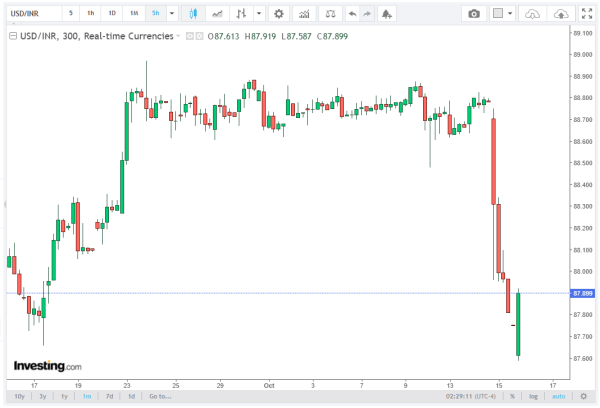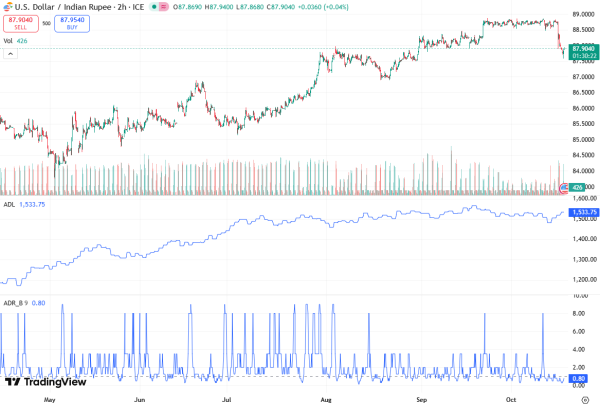The Indian Rupee (INR) struggles to extend its upside after a strong recovery move on Wednesday, as investors await clarity on the United States (US) claims regarding India’s oil imports from Russia.
The USD/INR pair stabilizes near 87.70, reflecting a cautious market sentiment amid geopolitical tensions and evolving trade dynamics between India, the US, and Russia. Diego Silva, an experienced broker at ProMorion Group, shares a well-rounded and comprehensive overview of the topic.
US Claims India to Halt Russian Oil Imports
On Wednesday, the US President asserted that Indian Prime Minister Narendra Modi assured him that India will halt purchasing oil from Moscow.
The market is now awaiting an official response from New Delhi to confirm these claims. If the statement holds, it could have significant implications for India-Russia trade relations, especially considering that India is one of the largest importers of Russian crude oil.
The US-India trade relationship has experienced tension in recent months, particularly as Washington raised tariffs on imports from New Delhi to 50% in response to Indian purchases of Russian oil. The US criticized these imports, arguing that the revenue helps Moscow continue the war in Ukraine.
Domestic Factors: RBI Policy Outlook
On the domestic front, the Reserve Bank of India (RBI) has indicated room for further interest rate cuts. Minutes from the recent policy meeting highlighted downside inflation risks, signaling a supportive stance for economic growth.
This dovish stance from the RBI underpins the INR’s firm outlook, despite the recent stabilization in USD/INR. Investors are weighing both geopolitical factors and domestic monetary policy in their trading decisions.
US Dollar Under Pressure Amid Fed Dovish Bets
The US Dollar (USD) has extended its corrective move lower, pressured by dovish Federal Reserve (Fed) expectations, the ongoing US government shutdown, and heightened US-China trade tensions.
The US Dollar Index (DXY), which tracks the Greenback against six major currencies, trades 0.15% lower near 98.50 during the Asian session, marking the third consecutive day of losses. Traders are increasingly confident that the Fed will continue monetary easing, following the rate cuts initiated in September.
The CME FedWatch tool shows a 94.6% probability that the Fed will cut rates by 50 basis points (bps) to a 3.50%-3.75% range later this year. Boston Fed President Susan Collins supported further rate reductions, citing cooling labor market conditions and contained inflation risks.
US Government Shutdown and Global Trade Tensions
The US has entered its third week of government shutdown, with Democrats withholding support for a short-term funding bill in the Senate. Treasury Secretary Scott Bessent warned that the shutdown could cost the US $15 billion per week in lost output, according to Reuters.
Meanwhile, US-China trade tensions continue to escalate. The US President has signaled his intent to pressure China to stop buying oil from Russia, aiming to cut funding to Moscow and curb its actions in Ukraine.
The US recently imposed 100% additional tariffs on Chinese imports in response to export controls on rare earths and magnets, intensifying friction between the world’s two largest economies.
Technical Analysis: USD/INR Stabilization
From a technical perspective, the USD/INR pair has stabilized near 87.70 after a sharp selling move on Wednesday. The pair had broken out of a three-week consolidation range between 88.75 and 89.10, attracting renewed bid interest at lower levels.
The near-term trend remains uncertain, as the pair has dropped below the 20-day Exponential Moving Average (EMA) at approximately 88.58. Additionally, the 14-day Relative Strength Index (RSI) has fallen below 40.00, indicating potential for fresh bearish momentum if the level holds.
Key support levels include the August 21 low of 87.07, while the 20-day EMA is likely to act as resistance on any upward attempt. Traders will closely monitor INR reactions to geopolitical developments and RBI policy guidance for further directional cues.
Outlook
The USD/INR market is poised in a consolidation phase as investors balance geopolitical uncertainty, domestic monetary policy, and global macroeconomic trends. While the Indian Rupee struggles to extend its upside gains, the pair remains sensitive to any official statements from New Delhi regarding Russian oil imports.
Meanwhile, a weaker US Dollar amid Fed dovish bets, government shutdown risks, and global trade tensions provides some support for the INR. However, the technical indicators suggest caution, as the pair trades below key EMA levels and RSI readings point to potential downside risks.
In conclusion, traders should focus on geopolitical developments, RBI communications, and US economic indicators to gauge short-term trends in USD/INR, as global markets navigate a complex web of policy uncertainty and trade tensions.







